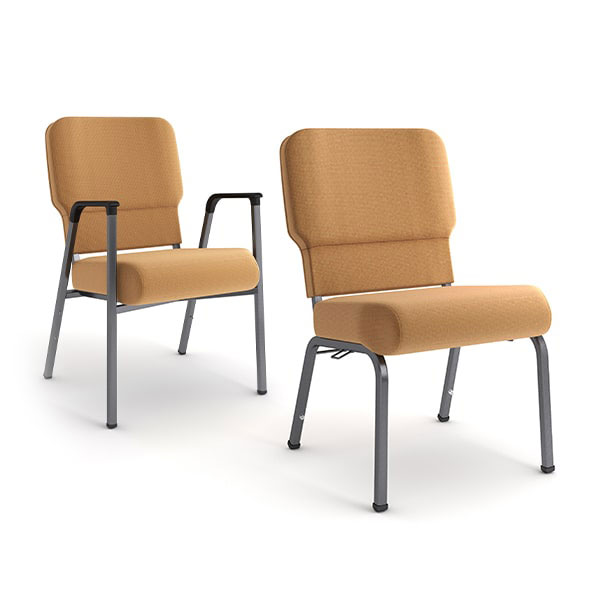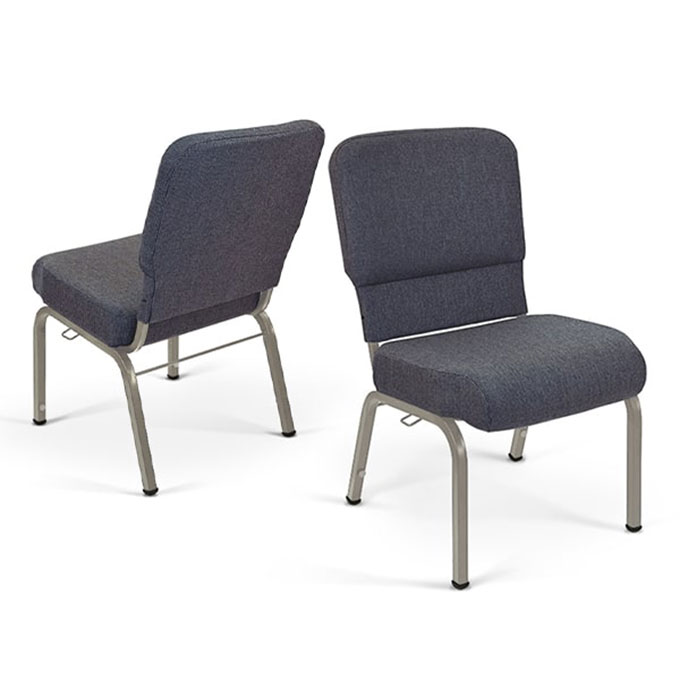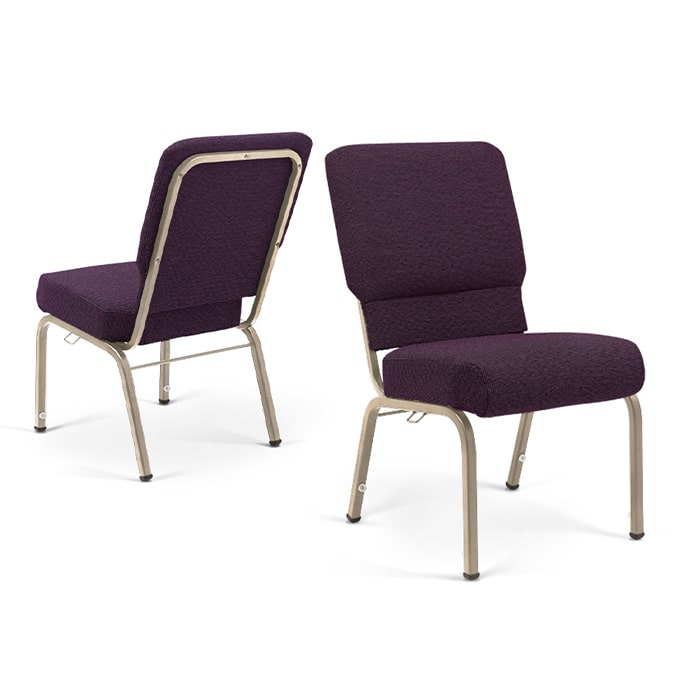For more than 60 years, Bertolini has partnered with churches and faith-based groups to help outfit their buildings with the best chairs. We know providing members with a comfortable and functional place to worship can be expensive. But an unfortunate fact of life is you get what you pay for.
What you will learn in this blog:
- How to get the money you need to purchase new chairs for your church
- Where to start in your fundraising process
- How to determine your “Fundraising Why”
- Different ways to fundraise
- How to create the best fundraising team
- How to hold a fundraiser with strong return on investment
- How to calculate your needs before you start planning
- A free fundraising flyer template
Although it’s true there are some cheap worship chairs out there, you should know there’s a hidden cost when you opt to save a few bucks on chairs. Inexpensive, poorly built, church chairs don’t provide a strong return on investment. They begin to fall apart shortly after purchase and need to be repaired and even replaced. They are also uncomfortable to sit in.
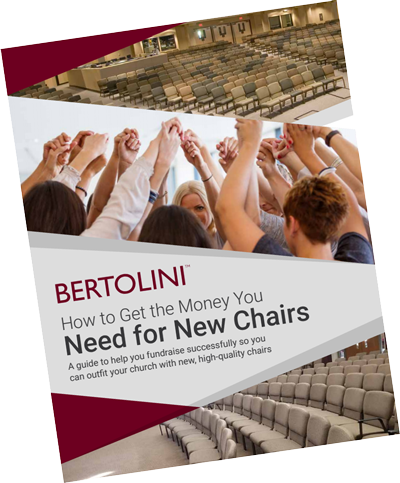
Get Your Free Fundraising Guide Today!
Get a complete guide to help you fundraise successfully so you can outfit your church with new, high-quality chairs.
We think your members deserve the best chairs on the market—chairs that will last for many years to come. If you don’t have enough in the budget to purchase the chairs you want, it is possible to raise the necessary funds.
Fundraising is one of the most important, yet one of the most challenging, aspects of church leadership. That’s why we’ve put together an ultimate fundraising guide to assist you. These tips can put you on the right path.
Section 1: What to Look for in Chairs

How do you know you’re purchasing the best chairs for your money?
It’s true that most church chairs look the same on the outside. This can make it difficult to ensure you’re getting the most for your money. However, you can’t judge a chair by its cover! What’s inside the chair is what matters, and that’s what sets apart the good chairs from the bad.
After reading this section, you will know exactly what questions to ask and what to look for when purchasing your chairs. We want you to feel confident in your investment.
How to choose the right chair frame
Steel frames are among the most durable types of chair frames. They are also among the least expensive and they offer the best storage capacity.
Look for a steel frame that is powder-coated to ensure the paint won’t chip or rub off. You may also want to look for frames that include a stack bar to minimize damage to cushions over time.
Why seats and backs matter
You should know what’s under the fabric and foam of a chair. The most common seats and backs are made from wood or plastic. Chairs with wood seats and backs are the most inexpensive, however, they are also the most uncomfortable and the heaviest to lift.
Plastic seat and back bases are more expensive, but they have many benefits. Plastic seat bases can be molded to the shape of the body, making them more comfortable. Plastic is as durable as wood and it has the same stacking capacity, but it’s lighter, easier to repair (with no screws to fall out), and more breathable.
Speaking of comfort, you may want to look for a chair with a flex-back option. A flex-back allows the sitter to lean back in the chair for individual comfort.
What you should know about foam
The type of foam you choose really matters because comfort level can change over time. Most foam cushions will feel comfortable at first. But cheap foam will break down quickly, losing the ability to bounce back after being crushed. With no bounce and support, a cushion loses its comfort level. When someone sits on a chair, they sink down to the seat base level immediately. This makes a foam seat cushion uncomfortable. Higher quality foam, on the other hand, can last 20 years or more, providing continued comfort and support throughout the use of a chair.
You’ll get more consistency in foam quality if you choose a manufacturer who makes their own foam, and it will be less expensive with no middleman.
The highest quality chairs will be made with polyethylene MDI foam, which is the most comfortable, durable, and environmentally friendly. Underneath the foam, look for a chair with a molded plastic seat base (as opposed to wood or metal) for the most comfortable seating experience.
Why footprint is important
Make sure you ask about the footprint of stacking chairs for storage purposes. You should look for chairs that stack for compact storage. Before you make a purchase, ask how many square feet one stack of chairs will take up. Also, ask how far the stack will creep out from the wall.
The rendering below demonstrates what we mean when we talk about stack footprint. Although stacking chairs may all seem comparable, once stacked, they different styles of chairs can have a larger footprint than another chairs, which means it will take up more storage space.
Why do we think Bertolini chairs are the best? We’re glad you asked!
Bertolini Church Chairs are manufactured using the highest quality, foam on the market. That’s why they are the most comfortable, and longest-lasting chairs you can buy.
Bertolini’s super comfortable foam seats
If a foam seat is too soft, a person will eventually sink through the foam after sitting for a long period of time. The seat will suddenly feel hard because you’re sitting on the seat bottom. This is called bottoming out. But, if the foam is too stiff, it will feel uncomfortable right away and make sitting for long periods of time uncomfortable.
Therefore, you want a foam seat that is neither too soft nor too stiff.
Bertolini offers different foam materials, depending on the model you select. Impressions Chair seats are made in-house with our own custom-molded, cold cure, high resilience foam. Our Millennia and Essentials Chairs are made with dual-density foam seats that include two foam pads—a soft pad on top and a firm (or dense) pad on the bottom, so that it feels soft while being firm enough to avoid bottoming out. At Bertolini, we go to great lengths in foam research and innovation to make sitting in a Bertolini church chair comfortable for any period of time.
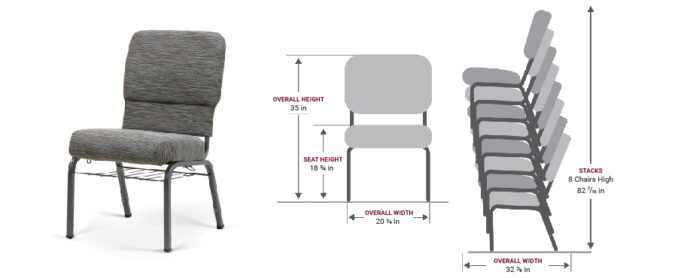
Section 2: Where to Start

When it comes to fundraising, it’s a common misstep for organizations to simply jump into planning an event without first stopping to figure out what type of fundraiser would best fit their needs, or if they even need to do a fundraiser at all.
Take the time to discuss your goals and make sure you’re headed in the right direction.
Before wasting valuable time and resources planning a large event, take the time to discuss your goals and make sure you’re headed in the right direction.
Start by asking these five questions:
1. How much do you need to raise?
Once you determine the chairs you want, you’ll need to estimate the number of chairs you need to order. Will you only purchase chairs for the worship area or do you need chairs for other rooms throughout the facility? If you have a rough idea of square footage and how the chairs will be used, a good sales representative should be able to help you estimate the order quantity.
Once you have this information, you’ll know your required budget and you can use that to determine how much additional money you need.
2. What type of fundraiser should you do?
There are many ways to fundraise successfully, but which is the best way for your church and your specific fundraising goal? Sometimes it’s simply a matter of calling for donations during a church service and sometimes a large event will be the best way to go.
Find fundraising ideas in Section 4.
3. Who should be involved?
If you are holding an event, it’s important to have your team in place before you begin planning. Start by choosing a leader or committee chair. Finding the right people to plan the event is central to success.
How do you find the right group? Discover traits to look for in Section 5.
4. How should you start planning?
Take the time to plan before selecting a date and announcing the fundraiser. This may sound obvious, but you’d be surprised how many churches simply announce that they are having a fundraiser before the details are in place. It’s important to know how much you need to raise and determine what type of fundraiser would be most fitting.
5. What’s the most important part of fundraising?
The Golden Rule of fundraising is, don’t be afraid to ask! That sounds simple, but it can be surprisingly difficult for some people. The reason it’s the Golden Rule is that the number one reason people don’t donate to a certain cause or organization is not that they cannot afford to donate, but because no one asks them to donate in the first place. Once you ask, you’ll likely be surprised by the generosity of the people you know.
Sometimes a Flyer Is All You Need
Perhaps after reading this e-book you will decide you’re not ready to launch a full-scale fundraising event. However, you might still need money for something like new chairs to outfit your church. That’s okay. Simple is sometimes better.
You’ll find a sample fundraising flyer in Section 8. You can use this as a template to create your own flyer or print the page and make copies to pass out during Sunday services.
Section 3: Know Your “Fundraising Why”

Do you know why you’re holding a fundraiser?
The most successful fundraisers have a specific goal or vision in mind. Simply needing more money to grow your church is not specific enough. For example, if you need to raise money in order toto purchase chairs for your church, make sure to communicate that clearly. The goal doesn’t matter if it’s communicated effectively to the membership. It’s particularly important to tell them how the fundraiser will benefit them. How will purchasing new chairs benefit them?
This also means you shouldn’t fundraise if it isn’t needed. People don’t like being bombarded with fundraisers, so don’t have one if there is no reason.
Once you have your “why,” the other aspects of fundraising will likely fall into place.
Churches fundraise for many different reasons, in addition to purchasing new furniture and supporting infrastructure. Here are just a few.
Common Causes for Church Fundraisers
Education:
- Church camp
- Bible school
- Sunday school
- Women’s groups
- Youth groups
- Children’s groups
- School uniforms
- Youth/adult conferences
Community Outreach:
- Missionary work
- Food pantries
- Ladies’ aid societies
- Homeless shelters
- Relay for Life and other health-related charities
Membership Services:
- Member healthcare aid fund
- J.O.Y. circles
- Sunday school supplies
- New building, expansion, or remodeling
- New church pews or chairs
- Ushers
Section 4: Different Ways to Fundraise

What type of fundraiser fits?
Depending on how much you need to raise to purchase your new chairs, different types of fundraisers might be best.
Because churches are community-based organizations, they’re in a unique position. There’s great potential for successful fundraising if you have a specific goal and can determine what type of fundraiser will help you achieve that goal.
Although many people think of large events or bake sales when the term fundraising is mentioned, there are many ways to raise money. Here are a few different types of fundraisers that might work for you and your church.
1. The $500 Dollar Wheelbarrow
A large wheelbarrow can hold at least 50,000 pennies, which equals $500. Put a wheelbarrow in your worship center and invite members to donate pennies. Or invite people to throw in loose change of any value and you might raise much more for your fundraising project.
2. Cupcake Bar
Have volunteers bake an assortment of unfrosted cupcakes that you can sell and then invite people to decorate as a fun activity. This is a great type of event to hold after a service. You can also sell coffee and tea!
3. World Food Day
Invite members from a variety of cultures to make their traditional cuisine for the congregation to sample, then charge for event tickets or by plates of food.
4. Talent Competition
Sell tickets to a show put on by your congregation’s youth group or children’s classes. People love to see kids perform!
5. Childcare Services
Offering childcare with the help of volunteers can provide a great service for couples in need of a date night and make a solid profit for you. Make sure that your childcare service complies with all state laws.
6. Cakewalk
Charge a participation fee for members to have an entry in a cakewalk, where volunteers walk around and taste each cake and then vote for a winner.
7. Gingerbread House Auction
Have volunteers spend an evening making gingerbread houses to be auctioned off after the next service.
8. Holiday Gift -Wrapping
Charge a small fee for volunteers to wrap presents for people in the congregation around the holidays.
9. Quiz Night
Charge admission and pick a theme such as a holiday or a “get-to-know-your-Bible-stories” event.
10. Car Wash
Gather volunteers and supplies and charge a small fee for the congregation and community members to get their cars cleaned.
11. Sell Reserved Seating
One way some churches raise the money for new chairs is to ask family members to buy a new chair for each family member or sell reserved seating. You could make placards for chair or church pews, if desired, always remembering to leave some spots open for visitors.
12. Bazaar
Find a bunch of volunteers and host your very own bazaar or market for selling miscellaneous items. Charge each booth a fee or have them donate a percentage of their profit to the church.
13. Member Auction
Have an auction where volunteers from your church can share their skills and talents with others. You can auction off things like a home-cooked meal, family photo session, yard work, and knitting. Get creative!
14. Flower Sale
Sell flowers during special holidays like Christmas, Valentine’s Day, Easter, Mother’s Day, etc.
15. Sell Engraved Bricks/Pavers
Invite people in your congregation to donate funds to support new church chairs, a remodel, a building expansion, or an outdoor BBQ or courtyard area. Donors who reach a certain level will be honored with an engraved brick, which can be incorporated into a wall, sidewalk, courtyard, or other area on the church property.
16. 5K Run/Walk
Host a 5K for the runners/walkers in the congregation with a set fee for each runner and the ability to gather donations to support teams and individual participants.
17. Golf Tournament
Speak with a local county club or golf course to see if you can arrange a fun tournament where a portion of the entry fee goes to your church.
18. Silent Auction
A silent auction can help augment ticket sales for an event or be part of something simple like an after-service luncheon.
19. Raffle
Gather in-kind donations to be raffled off at a silent auction. Donations could be services (such as a haircut, or a gift certificate for a local bed & breakfast) or goods. The auction can be held during a church service or activity or could be held online. This fundraiser method relies on the generosity of local businesses and the courage of a few donation-gatherers to hit up businesses for donations.
(Note: Check state laws regarding raffles to make sure you won’t be charged any taxes or fees. A raffle may not be a good idea for your congregation if the tax expense would cancel out any profit from the raffle.)
20. Family Movie Night
Select a popular or meaningful movie to show at a family movie night. Provide (or sell) snacks, seating, and drinks for a movie-night feel.
21. Catalog or Home Party
There are many catalogs and companies to choose from where people can purchase items and have a portion of their order total benefit the church. Look at popular companies like Scentsy, doTERRA, and Pampered Chef.
Section 5: Find Your Fundraising Team

The key to fundraising successfully is having a great team and a strong leader. Enlisting a dedicated group of people is the best way to ensure fundraising success, but it’s important to have a great leader in place to keep the project on track. This takes someone with the skillset, availability, and dedication to getting the job done.
Make sure your fundraising leader is the type of person who is not afraid to ask for what they need.
Is there someone in your congregation who often takes the lead, and who is looking for a way to get more involved? That person could be the leader you’re looking for!
Here are some traits to look for when searching for your fundraising team leader:
- Organized and enthusiastic
- Steps up to help without being asked
- Actively participates in discussion groups, classes, and events
- Communicates effectively
- Social and engaged (a “people person”)
- Flexible and easy to work with
- Avoids drama and gossip
What’s the #1 trait to look for? (Remember the golden rule!)
Make sure your fundraising leader is the type of person who is not afraid to ask for what they need.
People who might make great team members
Once you have your team leader, that person can help you put a committee in place. Look for people who have similar traits to your leader. Also, look for people with specific experience and skill sets you need to help make your event successful.
Potential volunteers
With a committee in place, figure out who else in your congregation should be involved. For example, if you are raising money for a youth group Bible camp, consider having members of the youth group actively participate. When people communicate directly with the people who will benefit from the fundraiser, they will be more likely to donate.
Section 6: Fundraising with Strong ROI

A fundraising event must be profitable, otherwise, you’re wasting your time and the time of all those involved. So, how do you host an event with a strong return on investment?
Follow these steps before you begin planning your event to ensure your final profits outweigh your initial investment. This works for any type of fundraiser from a simple bake sale to a large-scale gala.
Step 1: Confirm 501(c)(3) Status
If your church is a registered 501(c)(3) nonprofit organization, you should be charged the wholesale price by each vendor, and you don’t need to pay tax. If you’re not registered yet, pause the fundraising process until that’s in place.
Step 2: Create a Budget
List out every item you will need to purchase with an estimated cost. Remember the little things like printing event tickets and offering bottled water for volunteers. Tally the estimated total cost.
Step 3: Purchase Goods & Services
It’s time to approach vendors! As a 501(c)(3), you should be charged the wholesale price for everything and you should not be charged tax. And remember the golden rule! Ask for a percentage to be donated by the vendor or invite them to be a sponsor.
Step 4: Determine the Amount to Raise
Figure out how much money you need to raise to meet your goal once you subtract the cost for products and services.
Step 5: Establish Cost of Admission
Knowing how much you need to raise to reach your goal will help you determine how much to charge for admission or event tickets. Estimate how many people you think will attend and multiply that by the cost per ticket.
(Note: For small-scale fundraisers, such as a bake sale, you can determine how many items you need to sell and how much you need to charge for each item.)
Step 6: Identify Additional Revenue Options
It’s likely you won’t be able to raise the total amount needed through ticket sales alone. If the cost of entry is too high, it might limit attendance. Look for other ways to make money such as a raffle, silent auction, live auction, cash bar, or whatever else works for your members.
(Note: Get creative! For some events, you can raise additional money with things like carnival rides, balloon animals, and face painting.)
Section 7: Calculate Your Needs

How much money does your event need to raise? Use this formula to determine attendance goals, ticket prices, and more.
Using these calculations will help you know if your fundraising strategy can be successful. You might need to return to the drawing board, but it’s better to do that before you start investing time and money in an event that won’t achieve your goals.
Let’s take a look at how much you’ll need to raise to pay for new church chairs.
Does the ticket price seem too high?
Once you know how much you need to raise outside of ticket sales, you can begin pricing other items, such as drinks, and figure out how many donations you need to gather for raffles, auctions, etc.
Section 8: Fundraiser Flyer
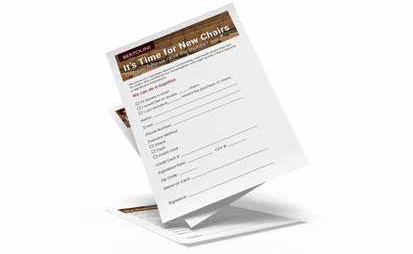
It’s time for new chairs! We’ll help you raise the money!
We think your members deserve to have the most comfortable, well-made chairs—ones that last for years, while being easy to set up and store. We also know that outfitting your congregation with high-quality chairs requires a significant investment.
Use this flyer as a model for creating your own fundraising flyer, or print out this flyer, make copies, and distribute it to your membership.
Good luck with your fundraising goals!

Need a Fundraising Flyer?
Print this flyer and distribute it to your membership.

